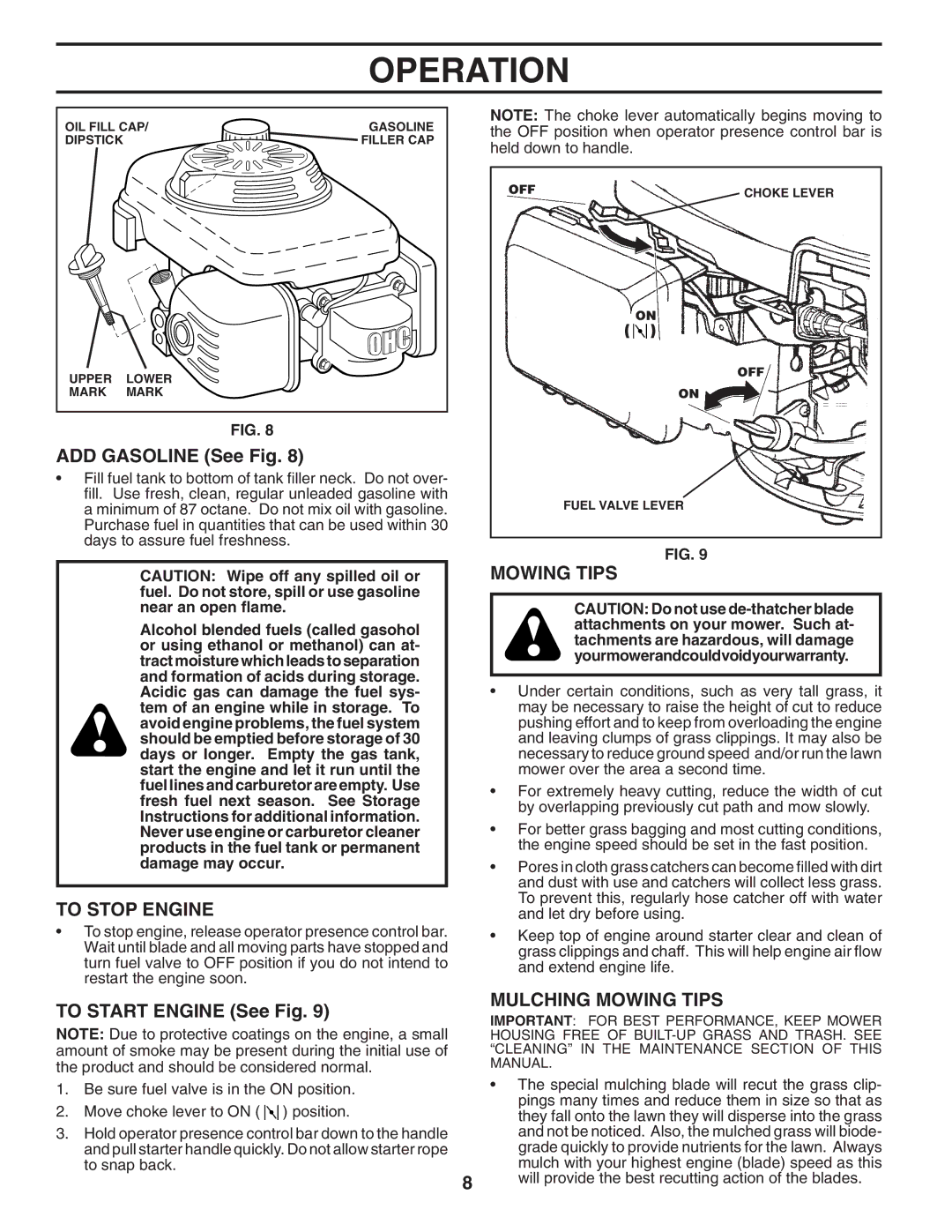
OPERATION
OIL FILL CAP/ | GASOLINE | |
DIPSTICK |
| FILLER CAP |
UPPER | LOWER |
|
MARK | MARK |
|
FIG. 8
ADD GASOLINE (See Fig. 8)
•Fill fuel tank to bottom of tank fi ller neck. Do not over- fi ll. Use fresh, clean, regular unleaded gasoline with a minimum of 87 octane. Do not mix oil with gasoline. Purchase fuel in quantities that can be used within 30 days to assure fuel freshness.
CAUTION: Wipe off any spilled oil or fuel. Do not store, spill or use gasoline near an open flame.
Alcohol blended fuels (called gasohol or using ethanol or methanol) can at- tract moisture which leads to separation and formation of acids during storage. Acidic gas can damage the fuel sys- tem of an engine while in storage. To avoid engine problems, the fuel system should be emptied before storage of 30 days or longer. Empty the gas tank, start the engine and let it run until the fuel lines and carburetor are empty. Use fresh fuel next season. See Storage Instructions for additional information. Never use engine or carburetor cleaner products in the fuel tank or permanent damage may occur.
TO STOP ENGINE
•To stop engine, release operator presence control bar. Wait until blade and all moving parts have stopped and turn fuel valve to OFF position if you do not intend to restart the engine soon.
TO START ENGINE (See Fig. 9)
NOTE: Due to protective coatings on the engine, a small amount of smoke may be present during the initial use of the product and should be considered normal.
1.Be sure fuel valve is in the ON position.
2.Move choke lever to ON ( ![]()
![]()
![]() ) position.
) position.
3.Hold operator presence control bar down to the handle and pull starter handle quickly. Do not allow starter rope to snap back.
8
NOTE: The choke lever automatically begins moving to the OFF position when operator presence control bar is held down to handle.
OFF | CHOKE LEVER |
ON
( ![]()
![]()
![]() )
)
OFF
ON
FUEL VALVE LEVER
FIG. 9
MOWING TIPS
CAUTION: Do not use
•Under certain conditions, such as very tall grass, it may be necessary to raise the height of cut to reduce pushing effort and to keep from overloading the engine and leaving clumps of grass clippings. It may also be necessary to reduce ground speed and/or run the lawn mower over the area a second time.
•For extremely heavy cutting, reduce the width of cut by overlapping previously cut path and mow slowly.
•For better grass bagging and most cutting conditions, the engine speed should be set in the fast position.
•Pores in cloth grass catchers can become fi lled with dirt and dust with use and catchers will collect less grass. To prevent this, regularly hose catcher off with water and let dry before using.
•Keep top of engine around starter clear and clean of grass clippings and chaff. This will help engine air fl ow and extend engine life.
MULCHING MOWING TIPS
IMPORTANT: FOR BEST PERFORMANCE, KEEP MOWER HOUSING FREE OF
•The special mulching blade will recut the grass clip- pings many times and reduce them in size so that as they fall onto the lawn they will disperse into the grass and not be noticed. Also, the mulched grass will biode- grade quickly to provide nutrients for the lawn. Always mulch with your highest engine (blade) speed as this will provide the best recutting action of the blades.
